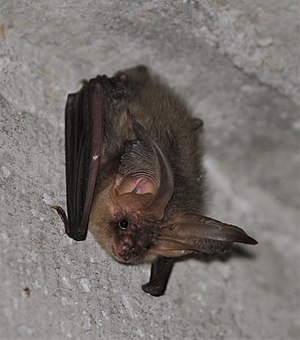Brown long-eared
| Brown long-eared | ||||||||||||
|---|---|---|---|---|---|---|---|---|---|---|---|---|

Brown long-eared ( Plecotus auritus ) |
||||||||||||
| Systematics | ||||||||||||
|
||||||||||||
| Scientific name | ||||||||||||
| Plecotus auritus | ||||||||||||
| ( Linnaeus , 1758) |
The brown long-ear ( Plecotus auritus ) is a species of bats of the genus Longears ( Plecotus ), to the family of smooth noses are counted (Vespertilionidae). It is also common in Europe, where it is one of the medium-sized native species.
description
The fur of the brown long-eared ear is long and loose and has a gray-brown color, the underside and the neck are clearly lighter gray and have a yellowish spot. The most noticeable feature are the ears, which are around 4 centimeters long and almost as long as the body. The front edge of the ear is heavily ciliated. The ears are erected at the beginning of the flight and remain set up in flight. During the daytime lethargy (torpor) and in hibernation, they are folded back under the wings. Especially in winter, the snout is significantly enlarged by the glands on the nose. Brown long ears reach a body length of around 42 to 53 millimeters, a wingspan of 24 to 29 centimeters and a weight of 5 to 11 grams.
distribution
Brown long ears are native to large parts of Eurasia . In Europe they are native to almost the whole continent with the exception of the extreme north and south, in Asia their range extends to the island of Sakhalin , Japan and the Himalayan region.
Way of life
Brown long-eared animals are forest dwellers to a greater extent than other long-eared species. They prefer loose deciduous and coniferous trees or parks, they often fly in dense undergrowth, with the wide wings contributing to maneuverability. They are also capable of rocking flight , in which the position remains unchanged with respect to a point fixed on the earth. They use trees as sleeping places, sometimes also bird or bat boxes or buildings. They use caves and mines as winter quarters during hibernation .
food
Brown long-ears eat insects, they mainly hunt medium-sized moths such as. B. Owl butterflies , two-winged birds and beetles . The prey is caught in flight with the help of the tail skin or the wings as a landing net. There are also direct from the vegetation flightless insects such as spiders , caterpillars , earwigs or harvestmen collected as food ( foliage gleaning ). During gleaning , the brown long-eared prey can be detected optically or by means of sounds; there is no location with the help of ultrasound sounds. Brown long-eared ears can collect prey from the vegetation while shaking. Larger prey are usually brought to a feeding place and eaten there. These feeding places can often be recognized by the body parts of butterflies lying on the ground.
Reproduction
As with many other European bat species, mating occurs in autumn. However, the semen is kept in the female's reproductive tract, and fertilization only occurs in spring. In June a single young is usually born, which becomes sexually mature after a year. A brown long-eared figure was discovered in Siberia and was 38 years old.
Systematics
Genetic studies have shown that some bat populations, previously considered to be subspecies of the brown long-eared bat, are species of their own. These include the Sardinian long-eared and Plecotus macrobullaris , under which the Alpine and the Caucasian long-eared are summarized.
literature
- Christian Dietz, Otto von Helversen , Dietmar Nill: Handbook of the bats of Europe and Northwest Africa. Biology, characteristics, endangerment. Kosmos, Stuttgart 2007, ISBN 3-440-09693-9 , ISBN 978-3-440-09693-2
Web links
- Information and images on Fledermausschutz.de
- Brown long-eared at NABU Schleswig-Holstein
- Plecotus auritus inthe IUCN Red List of Threatened Species 2018.1. Posted by: Hutson, AM, Spitzenberger, F., Aulagnier, S., Coroiu, I., Karataş, A., Juste, J., Paunovic, M., Palmeirim, J. & Benda, P., 2008. Retrieved on October 30, 2018.
Individual evidence
- ↑ Wilfried Schober, Eckard Grimmberger: Bats of Britain and Europe . Ed .: Robert E. Stebbings. The Hamlyn Group Limited, London 1993, ISBN 0-600-57965-4 , pp. 166 .
- ↑ Dietz et al. P. 349f.

